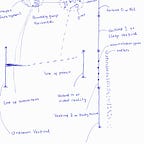Generative AI Chatbots: How the Brain Contrasts LLMs Pattern Matching Architecture
LLMs are simply known to work with statistical likelihood of what the next text would be, using the transformer architecture.
The brain, in neuroscience, is believed to generate predictions, using an internal model, to match the incoming external model, correcting the error in cases that don’t initially match.
LLMs are accurate where the texts generated are consistent with facts. They often generate as they do, sometimes resulting in making up stuff or inaccuracies.
For the brain, it is believed that there is often a correction, so that if what was initially predicted was inaccurate, it is still possible to get it right.
AI chatbots were developed based on this prediction model, but the inability for them to self-correct shows that the brain does more than prediction or error correction and that they imitated the periphery.
The human brain does not generate predictions, even though perceptive experiences appear like predictions. When an individual is reading and what is likely to come after a word is presented in mind, if it is right, the reading goes on, if not the right thing is seen, and the ‘prediction error’ is corrected, what happens in the brain?
Also, when an individual is talking, typing, writing or signing, with the next things, prepared in mind, to be expressed, is it similar to predictions? When something is briefly held in mind, referred to as working or short-term memory, the relay for each, say for numbers or alphabets, as inputs then outputs, are they similar to how predictions supposedly work?
It is hypothesized that the human mind is the collection of all the electrical and chemical impulses of nerve cells, with their features, in sets and their interactions. All mind processes are the interactions of impulses, whose features in sets [of circuitary neurons for functions] determine all experiences.
It is theorized that a key feature of sets of electrical impulses explaining what is observed as predictions is called early-splits or go-before, where some in a set break out from others, to relay for interactions with sets of chemical impulses like had been done previously. If the first one matches, then no correction, if not, the incoming one goes in the right direction.
There are two other features of sets of electrical impulses that are postulated to assist early-splits, called sequences and prioritization. Sequences could be old and new. They are relay paths with which sets of electrical impulses travel to reach sets of chemical impulses. Old sequences define procedures or routines, like grammar, methods, directions and so forth. Old sequences can be disadvantageous where they lead to boredom or when something is cliché. New sequences are useful to learn, for adventure, exploration and the rest. Sequences can lead to rejection of a split, where, if the split takes a new direction or sequence from the old or usual, there is a felt error as well, then the other split may follow.
Prioritization explains attention. It is the interaction with the most significance on the mind in a moment. Other interactions are pre-prioritized, where there are fast and numerous interchanges with prioritized. All interactions must be prioritized on the mind per cycle. Domination of prioritization of a few interactions could lead to defects of others or problems. Prioritization can be a result of the first split.
Many perceptions are sometimes initial experiences of the external world, where one sound may seem like another, until it is clearer, or more comes in, or a sight of something like another and so forth. This is simply by splits, which one becomes prioritized and goes through an old sequence. If it matches great, if not, the other incoming ones make corrections.
Splits are also responsible for decisions in moments, weighing risks and consequences, or appropriateness, not just to know that napping is fine, but where, when and how.
A way that splits might happen is proposed to be by saltatory conduction, which is how electrical impulses are insulated and jump from node to node in myelinated axons, going faster than in unmyelinated axons, in their continuous conduction.
In a set of incoming electrical impulses, over myelinated axons, some split by leaping together than others in their set, getting prioritized and proceeding through a sequence, to go first, to decide an early perception.
Sequences are by synaptic parallels of different neurons in a set. Each neuron has thousands of synapses. Those in a set, with their electrical activities may travel through parallel synapses, defining the sequence.
Prioritization is by rotations of a set of chemical impulses at synapses that form a loop, where after getting struck by a set of electrical impulses have a displacement that results in prioritization in a moment, for that interaction, before switches to others are made. Prioritization could also be driven from drifts or stairs of a set of chemical impulses, where intentionality or control is.
This, conceptually, is how what is called predictions happen on the human mind and what generative AI chatbots are missing. Electrical impulses split widely in a set, most of them end up in pre-prioritization, along with several others on the mind but just one is prioritized. They strike sets of chemical impulses for rationing or fills, to shape what is known or experienced.
Patterns in the brain are not just about splits, they could be about sequences — or path, as well as about degrees of prioritization — or rotation of the sets of chemical impulses. They could also be about the drifts of chemical impulses, or the jumps over myelin sheaths by those that are relay concurrently.
LLMs pattern match directly by statistical significance, which can be largely accurate, but have no pre-prioritization switches and splits that can return back to correct when the facts are amiss.
It is possible to explore a better pattern matching architecture for correction for LLMs, in important applications like medicine, or for emotional drifts, towards AI safety.
